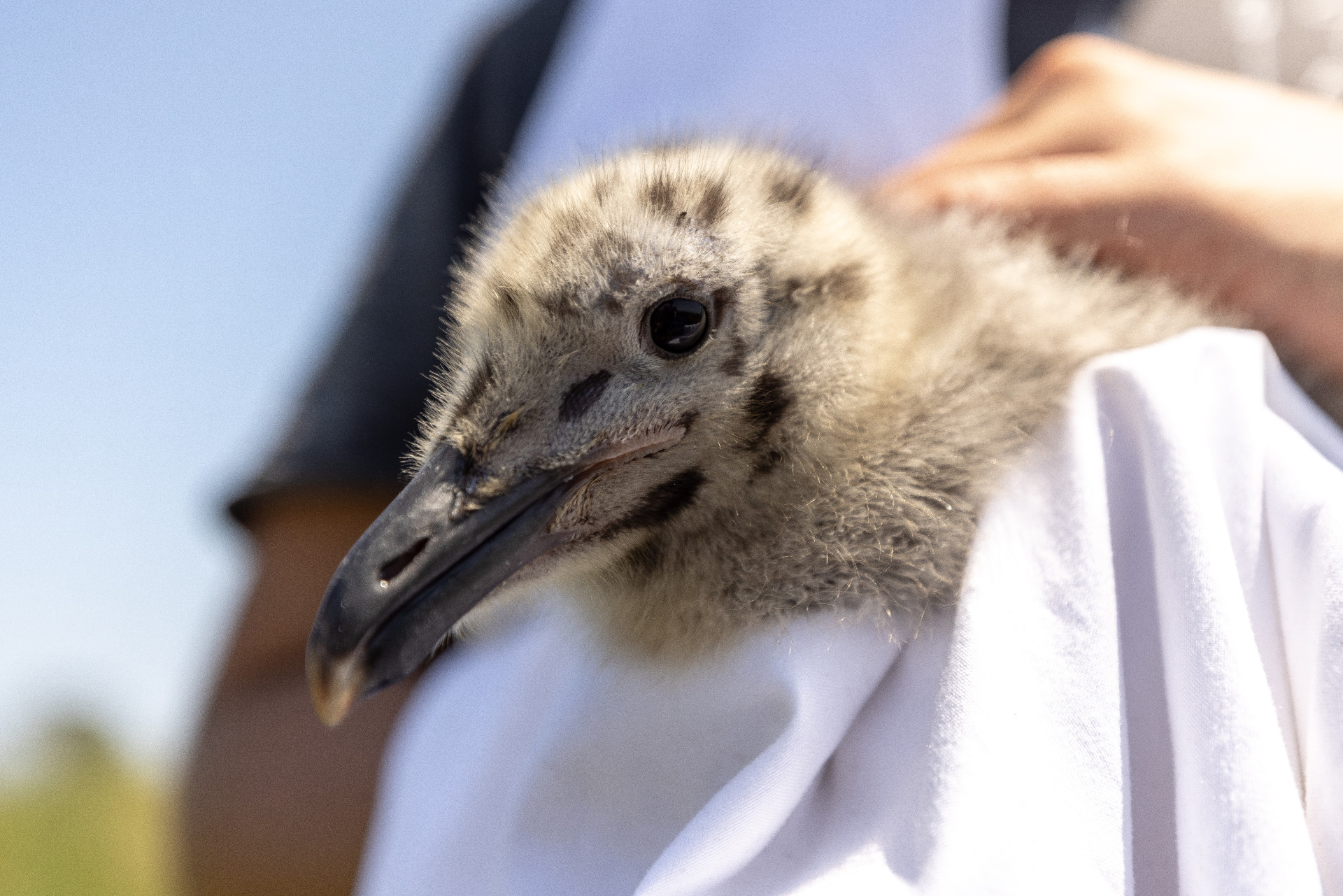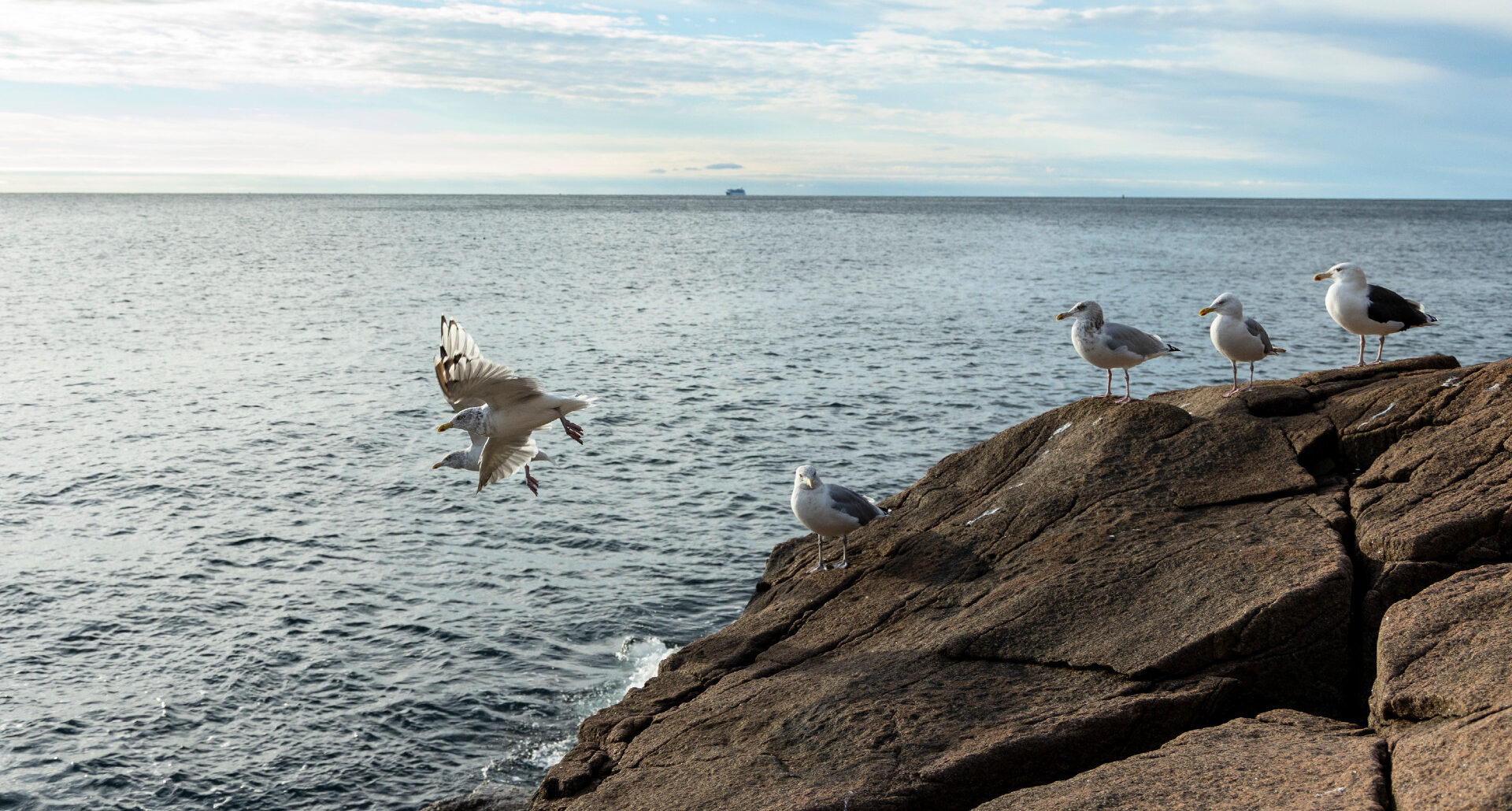Keep Your Eye on the Gull
A Seabird Study Grant from Friends of Acadia supported a survey of Acadia National Park’s seabird islands & the deployment of GPS tags on seven herring gulls this summer.
September 21st, 2023
A Seabird Study Grant from Friends of Acadia supported a survey of Acadia National Park’s seabird islands & the deployment of GPS tags on seven herring gulls this summer.
September 21st, 2023
BY SHANNON BRYAN
“One of the things that I think a lot of visitors to Acadia don’t realize is, they assume that Acadia is only the 40,000 acres of Mount Desert Island,” said John Anderson, professor of ecology and natural history at College of the Atlantic in Bar Harbor. “It isn’t.”
“The park has over 120 islands that it owns or has easements on,” he said. “That’s pretty substantial.”
Among those are 13 important seabird islands – rocky offshore spots relatively free from predators where cormorants, gulls, black guillemots, and Leach’s storm-petrels go to nest and raise young. The crown jewel of those, Anderson said, is Schoodic Island.
Located about a half-mile off the coast of the Schoodic Peninsula, 67-acre Schoodic Island has large nesting colonies of gulls and cormorants.
“It’s very close to the shore, and yet it’s managed to hang onto its birds,” said Anderson. “It’s absolutely fascinating.”
As College of the Atlantic faculty and the field station director at the college’s Alice Eno Biological Station on Great Duck Island, Anderson has studied the region’s seabirds for three decades.
Great Duck has possibly the oldest gull colony in the northeast, he noted. Since 1999, he’s taken teams of students out to Great Duck to study the gulls there, some students staying on the island for weeks at a time.
That research offers insights relevant to the region’s seabirds, including nesting colonies on park islands. But this year, with support from a grant from Friends of Acadia, Anderson and his team were able to further expand on that research. It’s important work in a ecologically unique place.
“Maine is in a really wonderful place, and this is where Acadia National Park is so critical because we’re right on the ecotone – a dividing zone between two very different floras and faunas,” Anderson said. “We’re right where a lot of northern species end up and where a lot of southern species end up.”

College of the Atlantic student and seabird researcher Autumn Pauly holds a Herring Gull (Larus argentatus) chick to show visitors while they visit College of the Atlantic’s Great Duck Island to learn about the seabird research happening on the island. (Photo by Sam Mallon/Friends of Acadia)
The grant from Friends of Acadia supported Anderson and his students to conduct a survey the park’s seabird islands, which hadn’t been done in a decade. The survey identified which of Acadia National Park’s islands had seabirds (“There’s a limited number of islands that are suitable for seabirds,” Anderson said. “If the island has a dense spruce forest, it’s not going to have nesting seabirds.”)
It also tallied the number of nests on several of those islands and mapped where each of those nests was located.
“We have high precision GPS, so we’re able to get the nests mapped to within half a meter of accuracy,” said Anderson. The data provides a useful comparative baseline—Anderson and his students can compare the numbers now versus 10 years ago—and it’s critical data to enable researchers to track population shifts over time and as the climate changes.
“Somebody can go back five, 10, 20 years from now and they can see not only whether there were birds there, but whether they’re nesting in the same location.”

College of the Atlantic student and seabird researcher Autumn Pauly holds a Herring Gull (Larus argentatus) chick to show visitors on Thursday, July 20, 2023 while they visit College of the Atlantic’s Great Duck Island to learn about the seabird research happening on the island. (Photo by Sam Mallon/Friends of Acadia)
The grant also enabled Anderson and his students to deploy solar-powered GPS tags on seven Schoodic Island herring gulls this summer. The tags tie into the cellular network, and every day at noon, the tracking information downloads and tells Anderson and his students where the gulls have been for the last 24 hours.
“That allows us to see movement patterns, where are they coming from, where are they going,” said Anderson. Gulls from Great Duck have worn different GPS tags for the last several years, and being able to now compare the comings and goings of both populations helps researchers better understand the ways in which the colonies might differ or overlap.
“Gull are incredible creatures of habit,” said Anderson. The gulls from Great Duck tend to travel to Little Cranberry Island and locations west, like Deer Isle and Blue Hill Bay—but never to Frenchman Bay. Gulls from Schoodic Island go to Winter Harbor, Bar Harbor, and Frenchman Bay—but never to Blue Hill Bay.
Where might the Schoodic Island birds go when they leave this area as colder weather rolls in?
“If they’re like Great Duck birds at all, some of them are probably going stick around Frenchman Bay and some of them maybe off to Virginia,” he said. “We could get birds that go to Bermuda, go to Chesapeake, go to Florida or Louisiana or the Great Lakes.
Gulls sometimes detour to unexpected places, too.
“We had one very odd bird that had a GPS tag on from Great Duck that took off from Great Duck, flew down the coast, and for reasons I still don’t understand, when he got into New Hampshire, he hung a right and went up into the White Mountains and spent a day or two hanging out in the Whites,” Anderson said. “And then he came back down to the coast and went on down to Virginia.”

Charlotte Willis of New Rochelle, NY and her “new friend,” a herring gull, hang out in the Schooner Head Overlook parking lot in Acadia National Park. (Photo by Avery Howe/Friends of Acadia)
"To me, the first step of learning is knowing what you’re working with, and thanks to Friends of Acadia, we’ve got such a huge jump on it this year."
John Anderson, College of the Atlantic
The surveys and tracking are important for protecting the park’s natural resources and biodiversity, said Anderson. But there’s an even more immediate reason:
“For the last number of years, we’ve been aware of a form of avian influenza—highly pathogenic avian influenza (HPAI)—which has had devastating effects on seabird colonies in Europe, Alaska, and more recently down on the Pacific coast.
HPAI is a changing virus, he said, meaning the actual structure of the virus can shift very suddenly, and that fools your immune system. It can also jump species.
“It started showing up in seabirds. It’s now showing up in mink. It’s showing up in fox. It’s showing up in seals,” said Anderson. “And there are at least two known cases of people getting it. So that’s really worrying.”
With seabird populations that frequent the mainland, and a national park that sees millions of visitors every year, monitoring is essential.
“From Acadia’s point of view, part of it is about resource management protection. Part of it is also about visitor experience. We want people to be safe,” said Anderson. “If HPAI were discovered in Maine birds, we’d want to know which islands are involved. We also want to know where those birds are going and how they might interface with the general public.”
Tracking data from the GPS tags is critical to the epidemiology, Anderson said, “because gulls don’t migrate, they disperse.”
Much like college students leaving a central campus to go home for the summer, some stay close to campus, others scoot off to far-flung states.
“Knowing where the birds are going gives us potential insights into where they might pick up disease and also spread disease,” Anderson said. There remains a good deal of unknowns with HPAI. Researchers don’t yet have answers to critical questions.
“We’re learning as we go,” he added. “To me, the first step of learning is knowing what you’re working with, and thanks to Friends of Acadia, we’ve got such a huge jump on it this year.”

Gulls perch and take off from the rocks along the Ocean Path in Acadia National Park. (Photo by Lily LaRegina/Friends of Acadia)
Monitoring the seabird islands is additionally important as the climate changes.
“We’re going to be seeing not only sea level rise, but we’re also going to be losing vegetation as a consequence of changes in temperature,” said Anderson. “Schoodic Island isn’t going to be Schoodic Island anymore. It’s going to be two little islands because of sea level rise. The vegetation on it is probably going to be very different vegetation.”
One of Anderson’s students spent this summer identifying vegetation around herring gull nests to better understand what vegetation, or lack thereof, encourages or discourages nesting.
“I think it’s critically important to monitor,” said Anderson. “I think it’s critically important to try and understand. These are all thing the Friends of Acadia grant encourages us to do.”
And while the research is crucial, the work has another meaningful effect:
“The Friends of Acadia grant is so great because it gave me a perfect excuse to take half a dozen really bright kids and put them on an island doing real research and handling real birds—for a purpose. But also, in the process of handing those real birds, falling in love with them.”
Friends of Acadia members make this work possible.
Join us and help preserve, protect, and promote stewardship of the outstanding natural beauty, ecological vitality, and distinctive cultural resources of Acadia National Park.
Become a Friends of Acadia member